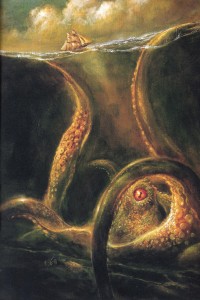It’s no secret we love all things ocean and sea legends just come with the territory. This week we are rounding up a few of our favorites: the Kraken, Sirens, and Mermaids. You may have heard of some of these legendary creatures thanks to Disney’s Pirates of the Caribbean. If you have kids you can thank SpongeBob SquarePants and Disney for the introduction.
Until we come face-to-face with these creatures, the tales will just have to do although we’re not sure how close we would want to get.
Enjoy!
The Kraken

As early as the 13th century sailors have been telling tales of two massive sea creatures one of which was the Kraken. Rumors pointed to sightings off the shores of Norway and Iceland; the Kraken was described in many different ways depending on the era.
The Kraken is incontestably the largest Sea monster in the world with a width of one and a half miles. It was also noted to have had starfish type protuberances: it’s arms would be able to get a hold of the largest man-of-war and pull it down to the bottom.”
Tall tales of the Kraken grabbing hold of ships with its tentacles and engulfing them from the bottom all the way to its main mast still circulate the seas. Its grip would bring down the ship and its sailors with it and they would be taken by the sea. Kind of like the final scene with Jack Sparrow where the Kraken takes down the Black Pearl.
Cool, huh? But we want nothing to do with it!
Sirens and Mermaids
Beautiful, mysterious, and at times, down right dangerous. Tails (see what we did there) of Sirens and Mermaids have been told by sailors and travelers for centuries; in fact in some languages they are both the same creature.
Sirens in Greek mythology were sea nymphs who lived on an island called Sirenum scopuli, but there are different locations depending on the tradition in which the tale is told. These beautiful naiads would enchant sailors and travelers with their siren song and cause them to sail their ships into cliffs and drown.
There were some cases of men thwarting their siren song.
The first were the Argonauts who had Orpheus play a tune louder than the Sirens.
The second was Odysseus’ men who plugged their ears with beeswax. Odysseus alone volunteered to hear the song while tied to the ship’s mast.
This second escape caused the Sirens to kill themselves out of shame. It was then said that Sirens were destined to die should someone hear their song and escape unscathed.
Mermaids
 Mermaids, on the other hand, come from mer which means sea and maid(en) which is a legendary creature human from the torso up and fish-like down.
Mermaids, on the other hand, come from mer which means sea and maid(en) which is a legendary creature human from the torso up and fish-like down.
The earliest Mermaid story comes from Assyria around 1000 BCE. Atargatis, an Assyrian priestess, jumped into the sea to wash away her shame of an unwanted pregnancy and emerged as a fishtailed goddess.
Seamen often spotted mermaids during the middle ages. Christopher Columbus among them saw three Mermaids on his first voyage to the Americas in 1493.
Mermaids figured prominently in sailors’ lore, because of such travellers’ tales.
The most common story was that Mermaids were incredibly skilled at seducing lonely sailors and dragging them down to their underwater kingdom. It was also believed that they could cause storms and shipwrecks.
Fun Fact:
We are all familiar with Disney’s beloved The Little Mermaid, but did you know how the tale originally came about? In the very first version of the story by Hans Christian Andersen, the mermaid sees her Prince marry a princess and she despairs. She is offered a knife to kill the prince with, but instead she jumps into the sea and dies by turning to froth. Hans Christian Andersen modified the ending slightly to make it more pleasant. In his new ending, instead of dying when turned to froth, she becomes a daughter of the air waiting to go to heaven.














